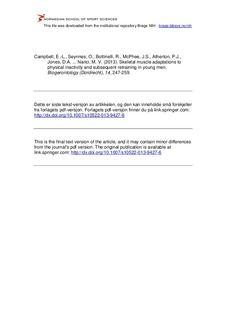| dc.contributor.author | Campbell, Emma-Louise | |
| dc.contributor.author | Seynnes, Olivier R. | |
| dc.contributor.author | Bottinelli, R. | |
| dc.contributor.author | McPhee, Jamie S. | |
| dc.contributor.author | Atherton, P. J. | |
| dc.contributor.author | Jones, D. A. | |
| dc.contributor.author | Butler-Browne, Gillian | |
| dc.contributor.author | Narici, Maco V. | |
| dc.date.accessioned | 2014-09-05T12:49:04Z | |
| dc.date.available | 2014-09-05T12:49:04Z | |
| dc.date.issued | 2013-05-12 | |
| dc.identifier.citation | Biogerontology (Dordrecht). 2013, 14, 247-259 | nb_NO |
| dc.identifier.uri | http://hdl.handle.net/11250/218864 | |
| dc.description | I Brage finner du siste tekst-versjon av artikkelen, og den kan inneholde ubetydelige forskjeller fra forlagets pdf-versjon. Forlagets pdf-versjon finner du på link.springer.com: http://dx.doi.org/10.1007/s10522-013-9427-6 / In Brage you'll find the final text version of the article, and it may contain insignificant differences from the journal's pdf version. The definitive version is available at link.springer.com: http://dx.doi.org/10.1007/s10522-013-9427-6 | nb_NO |
| dc.description.abstract | Skeletal muscle structure and function are markedly affected by chronic disuse. With unloading, muscle mass is lost at rate of about 0.4 %/day but little is known about the recovery of muscle mass and strength following disuse. Here we report an extensive data set describing in detail skeletal muscle adaptations in structure and function in response to both disuse and retraining. Eight young men (23 ± 2.2 years) underwent 3 weeks of unilateral lower limb suspension (ULLS) followed by a 3-week resistance training recovery program. Knee extensor isometric torque, voluntary activation, quadriceps femoris (QF) muscle volume (QFvol), fascicle length (Lf) and pennation angle (θ), physiological cross-sectional area (PCSA) of all four heads of the QF muscle, were measured before, after ULLS, and post-ULLS-resistance training. Needle biopsies were taken from the vastus lateralis muscle of a subgroup (n = 6) of the same subjects and cross sectional area of individual muscle s and myosin content of muscle samples were determined. Following 3 weeks of ULLS, isometric torque decreased by 26 %, PCSA by 3 %, QFvol by 10 %. Lf and θ of all four heads of QF significantly decreased (p ≤ 0.05). Following the 3-week retraining period, isometric torque, PCSA, QFvol, Lf and θ of all four heads of QF were all fully restored to pre ULLS values. CSA of individual muscle fibres and myosin content of muscle samples decreased by 26 and 35 % respectively (post-ULLS) and recovered to almost pre-ULLS values following retraining. There were no significant changes in voluntary activation of the quadriceps muscles in response to either ULLS or subsequent retraining. These results indicate that: (1) the loss of muscle force with 3-week unloading in humans is mostly explained by muscle atrophy and by a decrease in myosin content and, (2) all the neuromuscular changes induced by this model of disuse can be fully restored after a resistance training intervention of equal duration. | nb_NO |
| dc.language.iso | eng | nb_NO |
| dc.publisher | Springer Verlag | nb_NO |
| dc.subject | disuse | nb_NO |
| dc.subject | skeletal muscle | nb_NO |
| dc.subject | atrophy | nb_NO |
| dc.subject | recovery | nb_NO |
| dc.subject | resistance training | nb_NO |
| dc.title | Skeletal muscle adaptations to physical inactivity and subsequent retraining in young men | nb_NO |
| dc.type | Journal article | nb_NO |
| dc.type | Peer reviewed | nb_NO |
| dc.subject.nsi | VDP::Medical disciplines: 700 | nb_NO |
| dc.source.journal | Biogerontology (Dordrecht) | nb_NO |
| dc.description.localcode | Seksjon for fysisk prestasjonsevne / Department of Physical Performance | nb_NO |
